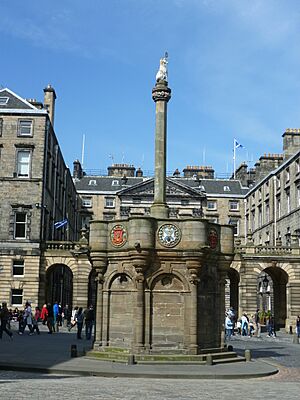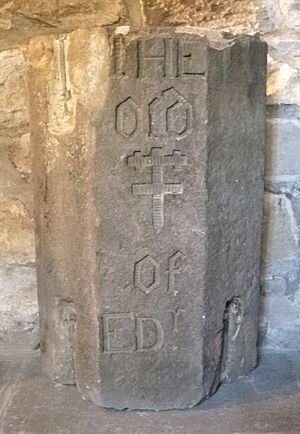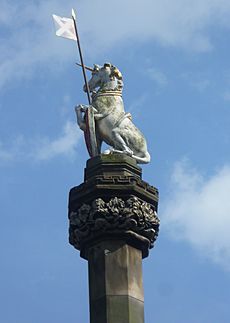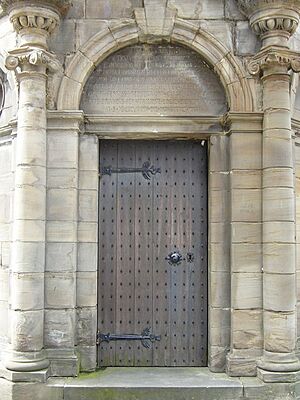Mercat Cross, Edinburgh facts for kids
The Mercat Cross of Edinburgh is a special stone structure that marks the main market area of Edinburgh. It stands in Parliament Square, right next to St Giles' Cathedral. You can see it from the High Street in Edinburgh's historic Old Town.
Contents
What is the Mercat Cross?
A mercat cross is a type of market cross found in many Scottish towns. It was a central spot where people gathered for trade and important announcements. The Mercat Cross of Edinburgh has been a key part of the city's history for centuries.
The Cross Through Time
The Mercat Cross you see today is from the Victorian era, but it's very close to where the first one stood. We know about the original cross from a document in 1365. It was about 45 feet (13.7 meters) from the east end of St. Giles' Cathedral.
In 1617, the cross was moved a bit further down the High Street. You can still see where it was, marked by a pattern of stones on the ground.
What Happened to the Old Cross?
Sadly, in 1756, the original cross was taken down. Some parts of its tall stone pillar were moved to the grounds of Drum House near Gilmerton. There's a monument there today that remembers the old cross.
Five round decorations with carved heads from the original cross were saved by the famous writer Sir Walter Scott. He put them in the garden wall of his home, Abbotsford House, in the Scottish Borders.
The Cross is Rebuilt
In 1866, the pieces of the cross from Drum House were put back together. They were placed on a new base on the east side of St Giles' Cathedral. Because the pillar had been broken, it was made shorter and thinner when it was rebuilt.
The cross was moved to its current spot in 1885. This new design was created by Sydney Mitchell. A kind man named William Ewart Gladstone, who was a Member of Parliament for Midlothian, paid for it. His family came from Edinburgh.
The carved heads on the original cross were replaced with new ones. These new carvings show the royal symbols of Britain, Scotland, England, and Ireland. They also show the symbols of Edinburgh, Leith, and The Canongate, plus the symbol of the University of Edinburgh.
Modern Changes to the Cross
The main shaft of the cross was replaced in 1970 during big repair work. Experts studied the stonework and found that the current structure includes two pieces of the old stone shaft. They also found that the top part of the cross is from the early 1400s. The unicorn statue on top is a copy from 1869, based on old descriptions.
On the east side of the cross, above a wooden door, there's a Latin message. William Ewart Gladstone wrote this message. It says:
Thanks to God. This old monument, the Cross of Edinburgh, which was used for public events long ago, was completely destroyed by a mistaken act in 1756. It was remembered and honored in a great song by the famous Walter Scott. Now, with permission from the city leaders, William Ewart Gladstone, whose family is completely Scottish on both sides, has restored it. November 24, 1885.
Important Events at the Cross
The Mercat Cross was a very important place for public announcements in Scotland.
Royal and Public Announcements
In Edinburgh, important news from the King or Queen and the Parliament was read aloud at the Mercat Cross. This included announcing new kings or queens and calling for general elections. Even today, special officials called heralds still read these announcements at the cross.
Historical Events and Punishments
The cross was also a place where serious events happened.
- In 1573, after a long fight for Edinburgh Castle, some people who had supported the Queen were executed at the cross.
- In 1604, Alastair MacGregor, the leader of an outlawed clan, was executed at the cross along with eleven of his relatives.
- In 1649, after King Charles I of England was executed, the Scottish Parliament announced his son, Charles II of England, as the new king at the cross. This was a challenge to the English Parliament.
- Important Royalist leaders, like George Gordon, 2nd Marquess of Huntly and James Graham, 1st Marquess of Montrose, were also executed here.
Changes in Power
When the English army took control, they made announcements at the cross too.
- In 1652, they announced that Scotland would join the Commonwealth of England. They even took down the King's symbols and hung them on the gallows.
- In 1654, General George Monck, the English military leader in Scotland, was there when they announced Oliver Cromwell as the leader of England, Ireland, and Scotland. They also confirmed Scotland's union with England. This union ended when the King returned in 1660.
After the King Returned
After the king came back, several people were executed at the cross for serious crimes against the government.
- Archibald Campbell, 1st Marquess of Argyll was executed in 1661.
- James Guthrie and Captain William Govan were executed in 1661.
- Archibald Johnston, Lord Warriston was executed in 1663.
- Some books that the King's government thought were dangerous were also burned at the cross.
Rebellions and Protests
The cross continued to be a place for important public events.
- In 1688, a crowd broke into the King's chapel and burned parts of it at the cross, along with a dummy of the Pope.
- In 1745, during a rebellion, "Young Pretender" Charles Edward Stuart had his father announced as King James VIII of Scotland at the cross. He was announced as Regent. People watched from their windows, some cheering and some staying silent. After the rebellion was defeated, the flags captured from the rebels were burned at the cross.
The Mercat Cross Medallions at Abbotsford
The images below show the five round medallions that were saved from the original Mercat Cross. They are now at Abbotsford House. The middle one shows the old symbol of Edinburgh. We don't know who the carved heads represent.











